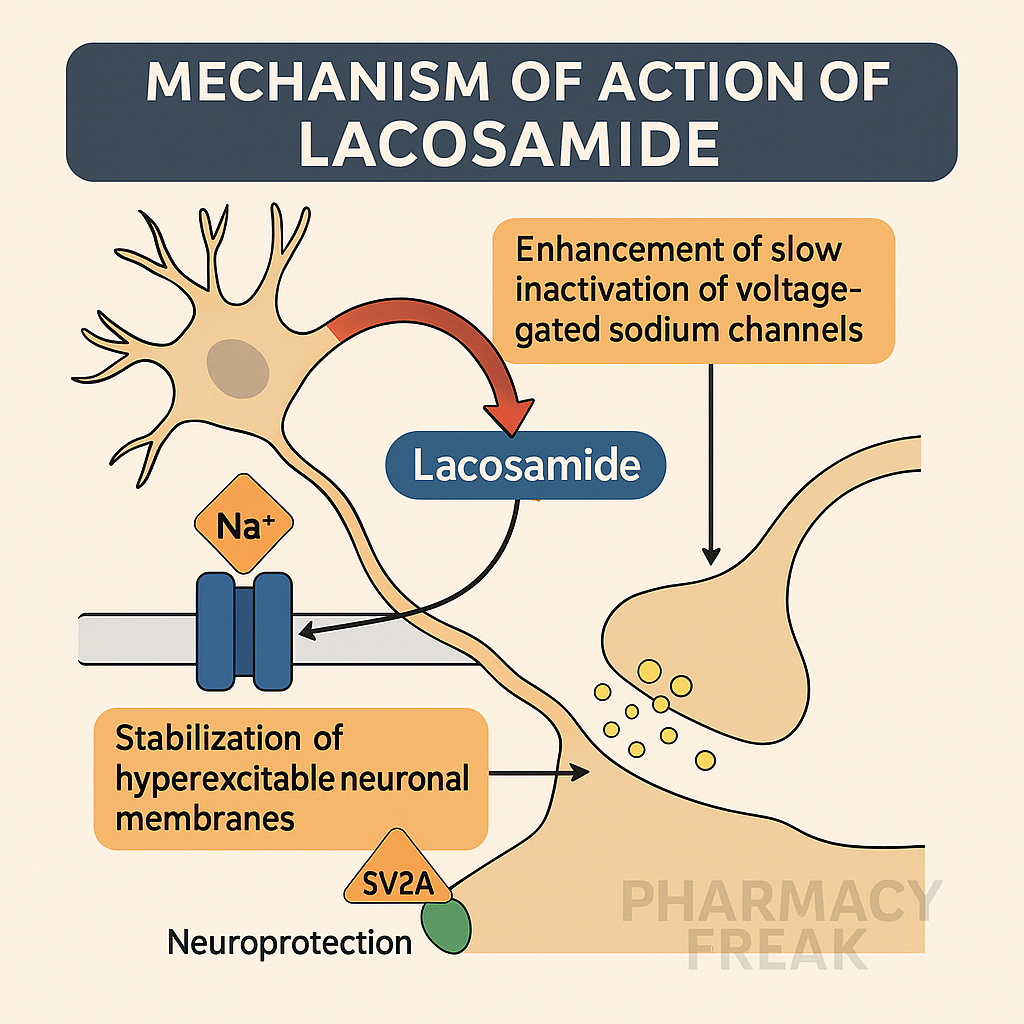Table of Contents
Introduction
Lacosamide is a newer-generation antiepileptic drug (AED) used for the treatment of focal (partial) seizures and adjunctive therapy for generalized seizures. It has a novel mechanism, targeting slow inactivation of voltage-gated sodium channels, which differentiates it from older AEDs. It is well tolerated and commonly prescribed in the US for both adults and children.
Due to its unique mechanism and growing clinical use, lacosamide is increasingly tested in USMLE, NCLEX, GPAT, and NEET-PG exams.
Stepwise Mechanism of Action of Lacosamide
- Enhancement of slow inactivation of Na⁺ channels
Lacosamide binds to voltage-gated sodium channels and selectively enhances their slow inactivation phase, unlike phenytoin or carbamazepine that target fast inactivation. - Stabilization of hyperexcitable neuronal membranes
This leads to reduced repetitive neuronal firing, especially in epileptic foci, without affecting normal neurons. - Modulation of CRMP-2 (Collapsin Response Mediator Protein-2) (under investigation)
Lacosamide may bind to CRMP-2, a protein involved in neuronal differentiation, although this role is not fully validated clinically.
Pharmacokinetic Parameters of Lacosamide
| Parameter | Value |
|---|---|
| Bioavailability | ~100% (oral) |
| Half-life | ~13 hours |
| Protein binding | ~15% (low) |
| Metabolism | Hepatic via CYP2C19 |
| Excretion | Renal (unchanged + metabolites) |
| Therapeutic range | Not routinely measured |
Clinical Uses of Lacosamide
- Focal (partial) seizures – monotherapy or adjunct
- Generalized tonic-clonic seizures (adjunctive)
- Secondarily generalized seizures
- Off-label uses being explored in status epilepticus and neuropathic pain
Adverse Effects of Lacosamide
- Dizziness
- Diplopia (double vision)
- Nausea and vomiting
- Ataxia
- Fatigue
- QT interval prolongation (ECG monitoring recommended)
- PR interval prolongation and AV block
- Euphoria-like symptoms (CNS effect)
⚠️ Schedule V controlled substance in the USA due to mild abuse potential.
Comparative Analysis: Lacosamide vs Carbamazepine
| Feature | Lacosamide | Carbamazepine |
|---|---|---|
| Na⁺ channel inactivation | Slow inactivation | Fast inactivation |
| Drug interactions | Fewer | Many (CYP450 inducer) |
| CNS side effects | Milder | Sedation, ataxia |
| Monitoring | ECG (for PR prolongation) | CBC, LFTs |
| Enzyme induction | No | Yes |
Practice MCQs
Q1. Lacosamide enhances which state of sodium channels?
a. Open state
b. Inactive state (fast)
c. Slow inactivation ✅
d. Closed state
Q2. Lacosamide is primarily used for:
a. Myoclonic seizures
b. Absence seizures
c. Focal seizures ✅
d. Status epilepticus
Q3. A proposed secondary mechanism of lacosamide involves:
a. GABA-A receptor binding
b. AMPA receptor blockade
c. CRMP-2 modulation ✅
d. Carbonic anhydrase inhibition
Q4. Which ECG abnormality may occur with lacosamide?
a. QT shortening
b. PR interval prolongation ✅
c. T wave inversion
d. ST elevation
Q5. What is the US scheduling of lacosamide?
a. Schedule II
b. Schedule IV
c. Schedule V ✅
d. Not scheduled
Q6. How is lacosamide excreted?
a. Bile
b. Renal ✅
c. Pulmonary
d. Saliva
Q7. Lacosamide differs from phenytoin by:
a. Enhancing Na⁺ fast inactivation
b. Modulating Ca²⁺ influx
c. Enhancing Na⁺ slow inactivation ✅
d. Blocking potassium channels
Q8. CNS adverse effects of lacosamide include:
a. Agitation
b. Diplopia ✅
c. Hallucinations
d. Memory loss
Q9. Can lacosamide be used as monotherapy?
a. No
b. Yes ✅
c. Only in children
d. Only in adults
Q10. What is the bioavailability of oral lacosamide?
a. 50%
b. 70%
c. 85%
d. ~100% ✅
FAQs
Q1: Is lacosamide effective in generalized epilepsy?
It is mainly used for focal seizures, but adjunctive use in generalized seizures is being explored.
Q2: Why is ECG monitoring needed?
Because of its potential to cause PR interval prolongation, especially in patients with heart conditions.
Q3: Can it be started without titration?
Yes, it has a favorable safety profile and can be titrated quickly.
Q4: Is lacosamide metabolized by liver enzymes?
Yes, via CYP2C19, but it does not induce or inhibit other enzymes significantly.
Q5: Is lacosamide safe in renal impairment?
Yes, but dose adjustment is necessary since it is renally excreted.
References
- KD Tripathi – Essentials of Medical Pharmacology
- Goodman & Gilman – The Pharmacological Basis of Therapeutics
- Sparsh Gupta – Review of Pharmacology
- NCBI: https://www.ncbi.nlm.nih.gov/books/NBK557852/

I am pursuing MBA in pharmaceutical management from NIPER Hyderabad with a strong academic record and proven success in national-level pharmacy entrance exams. I secured AIR 61 in NIPER 2024 (MS/M.Pharm) and AIR 27 in NIPER MBA, along with AIR 147 in GPAT 2024 and AIR 907 in GPAT 2023. I also achieved AIR 6 in AIIMS CRE-2025 for Drug Store Keeper and was selected as a Pharmacist (AIR 61) for ESIC. Additionally, I was the Runner-Up in Round 2 of the EY Case Study Competition.
At PharmacyFreak.com, I aim to guide future pharmacists through expert content, exam strategies, and insightful resources based on real experience and academic excellence.
Mail- harsh@pharmacyfreak.com
